Linearly Polarized Antenna Boosters versus Circularly Polarized Microstrip Patch Antennas for GPS Reception in IoT Devices
Abstract
1. Introduction
2. Components for the Testing
2.1. Antennas under Study
2.1.1. Linearly Polarized Antenna Booster
2.1.2. Circularly Polarized Microstrip Patch Antenna
2.2. GNSS Evaluation Kit
3. Testing Procedures
3.1. Static Setup
3.2. Dynamic Setup
3.2.1. Device Positions
3.2.2. Route
4. Results
4.1. Static Results
4.1.1. Cno
4.1.2. Number of Satellites
4.1.3. Dilution of Precision
4.1.4. TTFF in an Ideal Position in a Vehicle
4.2. Dynamic Setup
4.2.1. CNo
4.2.2. Number of Satellites
4.2.3. Dilution of Precision
4.2.4. TTFF Results by Device Positioning
- Front Dashboard
- Rear Dashboard
- Over the Seat
- Under the Seat
- TTFF Warm Star Summary by position
4.2.5. TTFF Cold Start
5. Discussion
6. Conclusions
Author Contributions
Funding
Conflicts of Interest
References
- Anguera, J.; Andújar, A.; Mestre, G.; Rahola, J.; Juntunen, J. Design of Multiband Antenna Systems for Wireless Devices Using Antenna Boosters. IEEE Microw. Mag. 2019, 20, 102–114. [Google Scholar] [CrossRef]
- Anguera, J.; Picher, C.; Bujalance, A.; Andújar, A. Ground plane booster antenna technology for smartphones and tablets. Microw. Opt. Technol. Lett. 2016, 58, 1289–1294. [Google Scholar] [CrossRef]
- GMV. TTFF. TTFF-Navipedia. 2012. Available online: https://gssc.esa.int/navipedia/index.php/TTFF (accessed on 2 September 2022).
- Pathak, V.; Thornwall, S.; Krier, M.; Rowson, S.; Poilasne, G.; Desclos, L. Mobile handset system performance comparison of a linearly polarized GPS internal antenna with a circularly polarized antenna. In Proceedings of the IEEE Antennas and Propagation Society International Symposium. Digest. Held in conjunction with: USNC/CNC/URSI North American Radio Sci. Meeting (Cat. No.03CH37450), Columbus, OH, USA, 22–27 June 2003; Volume 3, pp. 666–669. [Google Scholar] [CrossRef]
- Dai, Y.; Talty, T.; Lanctot, L. GPS antenna selection and placement for optimum automotive performance. In Proceedings of the IEEE Antennas and Propagation Society International Symposium. 2001 Digest. Held in conjunction with: USNC/URSI National Radio Science Meeting (Cat. No.01CH37229), Boston, MA, USA, 3–13 July 2001; Volume 1, pp. 132–135. [Google Scholar] [CrossRef]
- Yegin, K. On-Vehicle GPS Antenna Measurements. IEEE Antennas Wirel. Propag. Lett. 2007, 6, 488–491. [Google Scholar] [CrossRef]
- Serra, A.A.; Nepa, P.; Manara, G.; Massini, R. A Low-Profile Linearly Polarized 3D PIFA for Handheld GPS Terminals. IEEE Trans. Antennas Propag. 2010, 58, 1060–1066. [Google Scholar] [CrossRef]
- Specht, C.; Mania, M.; Skóra, M.; Specht, M. Accuracy Of The GPS Positioning System In The Context Of Increasing The Number Of Satellites In The Constellation. Pol. Marit. Res. 2015, 22, 9–14. [Google Scholar] [CrossRef]
- Matsunaga, M.; Suzuki, M. An electrically small three-band multi-polarization cross spiral antenna. In Proceedings of the 2015 9th European Conference on Antennas and Propagation (EuCAP), Lisbon, Portugal, 13–17 April 2015; pp. 1–2. [Google Scholar]
- Goncharova, I.; Lindenmeier, S. A compact satellite antenna module for GPS, Galileo, GLONASS, BeiDou and SDARS in automotive application. In Proceedings of the 2017 11th European Conference on Antennas and Propagation (EUCAP), Paris, France, 19–24 March 2017; pp. 3639–3643. [Google Scholar] [CrossRef]
- Boccia, L.; Amendola, G.; Di Massa, G. A shorted elliptical patch antenna for GPS applications. IEEE Antennas Wirel. Propag. Lett. 2003, 2, 6–8. [Google Scholar] [CrossRef]
- Liang, Z.; Li, Y.; Long, Y. Multiband Monopole Mobile Phone Antenna with Circular Polarization for GNSS Application. IEEE Trans. Antennas Propag. 2014, 62, 1910–1917. [Google Scholar] [CrossRef]
- Ferrero, F. Antenna Design for Miniature LR1110 Trackers: Challenges and First Experiment. Available online: https://www.youtube.com/watch?v=hQCg_5JLSM8&t=269s (accessed on 28 September 2022).
- Lai, Z.; Yuan, J. Design of single-layer single-feed patch antenna for GPS and WLAN applications. In Proceedings of the International Symposium on Antennas & Propagation, Lake Buena Vista, FL, USA, 7–13 July 2013; pp. 737–739. [Google Scholar]
- Ma, S.-L.; Row, J.-S. Design of Single-Feed Dual-Frequency Patch Antenna for GPS and WLAN Applications. IEEE Trans. Antennas Propag. 2011, 59, 3433–3436. [Google Scholar] [CrossRef]
- Diggikar, A.; Chinchpure, P.; Ingale, C.; Jog, S. Design and Development of Microstrip Patch Antenna for GPS Applications. In Proceedings of the 2018 Fourth International Conference on Computing Communication Control and Automation (ICCUBEA), Pune, India, 16–18 August 2018; pp. 1–4. [Google Scholar] [CrossRef]
- Rao, K.S.; Jahagirdar, D.R.; Ramakrishna, D. Compact broadband asymmetric slit Circularly Polarized Microstrip Patch Antenna for GPS and GLONASS applications. In Proceedings of the 2017 IEEE International Conference on Antenna Innovations & Modern Technologies for Ground, Aircraft and Satellite Applications (iAIM), Bangalore, India, 24–26 November 2017; pp. 1–3. [Google Scholar] [CrossRef]
- Adhikary, P.; Ray, S.; Chatterjee, S.; Ghosh, S.; Chattopadhyay, S.; Banerjee, S.; Dhar, A.K.; Das, A. Design and development of wearable patch antenna for GPS applications. In Proceedings of the 2019 IEEE International Electromagnetics and Antenna Conference (IEMANTENNA), Vancouver, BC, Canada, 14–17 October 2019; pp. 68–71. [Google Scholar] [CrossRef]
- So, K.K.; Wong, H.; Luk, K.M.; Chan, C.H. Miniaturized Circularly Polarized Patch Antenna With Low Back Radiation for GPS Satellite Communications. IEEE Trans. Antennas Propag. 2015, 63, 5934–5938. [Google Scholar] [CrossRef]
- Sun, C.; Zheng, H.; Liu, Y. Analysis and Design of a Low-Cost Dual-Band Compact Circularly Polarized Antenna for GPS Application. IEEE Trans. Antennas Propag. 2015, 64, 365–370. [Google Scholar] [CrossRef]
- Anguera, J.; Andújar, A.; Puente, C. Compact Antenna Technology for Wireless Communications. WO 2020120589A1, 2022. not granted yet. [Google Scholar]
- Isik, O.; Hong, J.; Petrunin, I.; Tsourdos, A. Integrity Analysis for GPS-Based Navigation of UAVs in Urban Environment. Robotics 2020, 9, 66. [Google Scholar] [CrossRef]

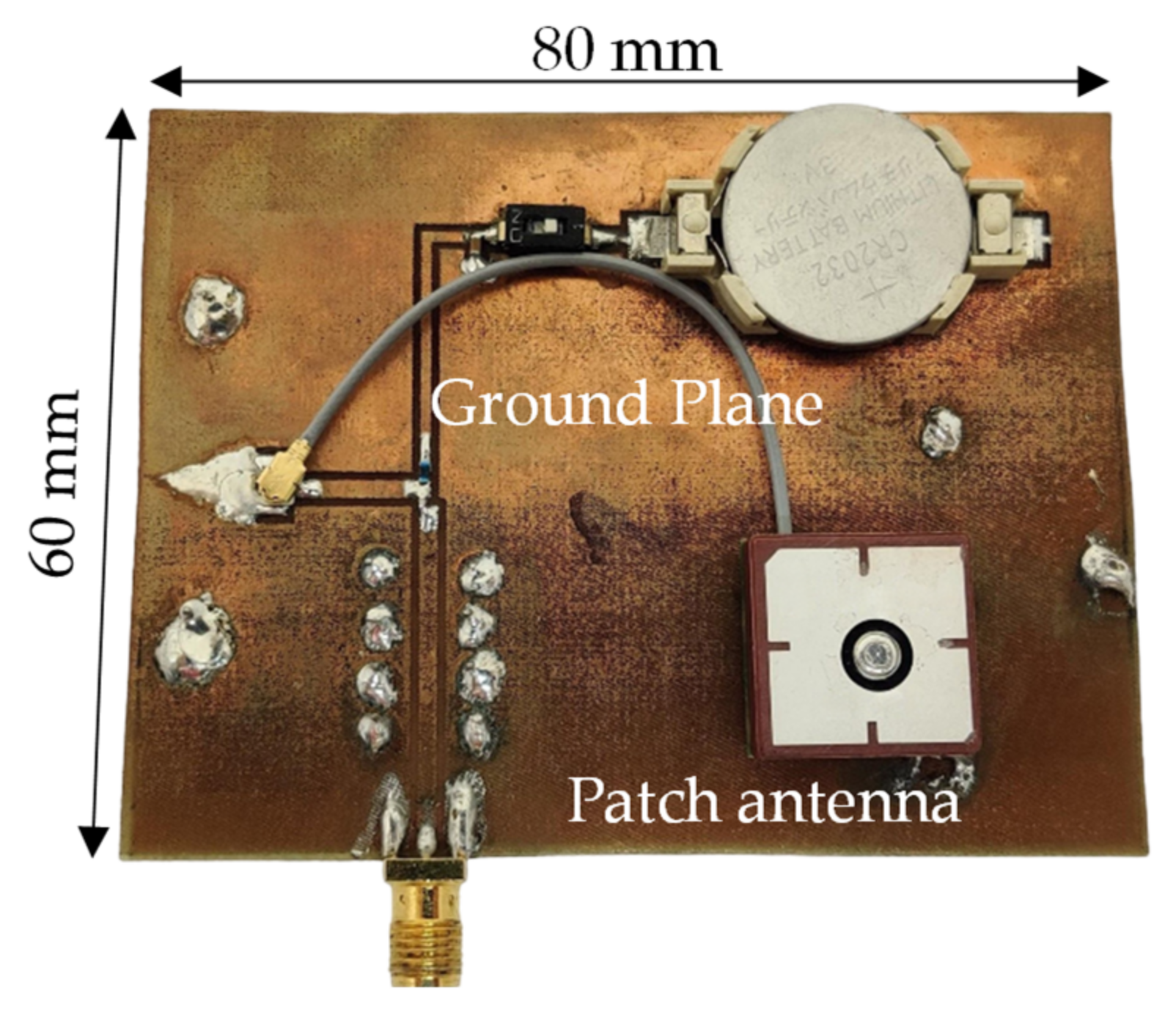

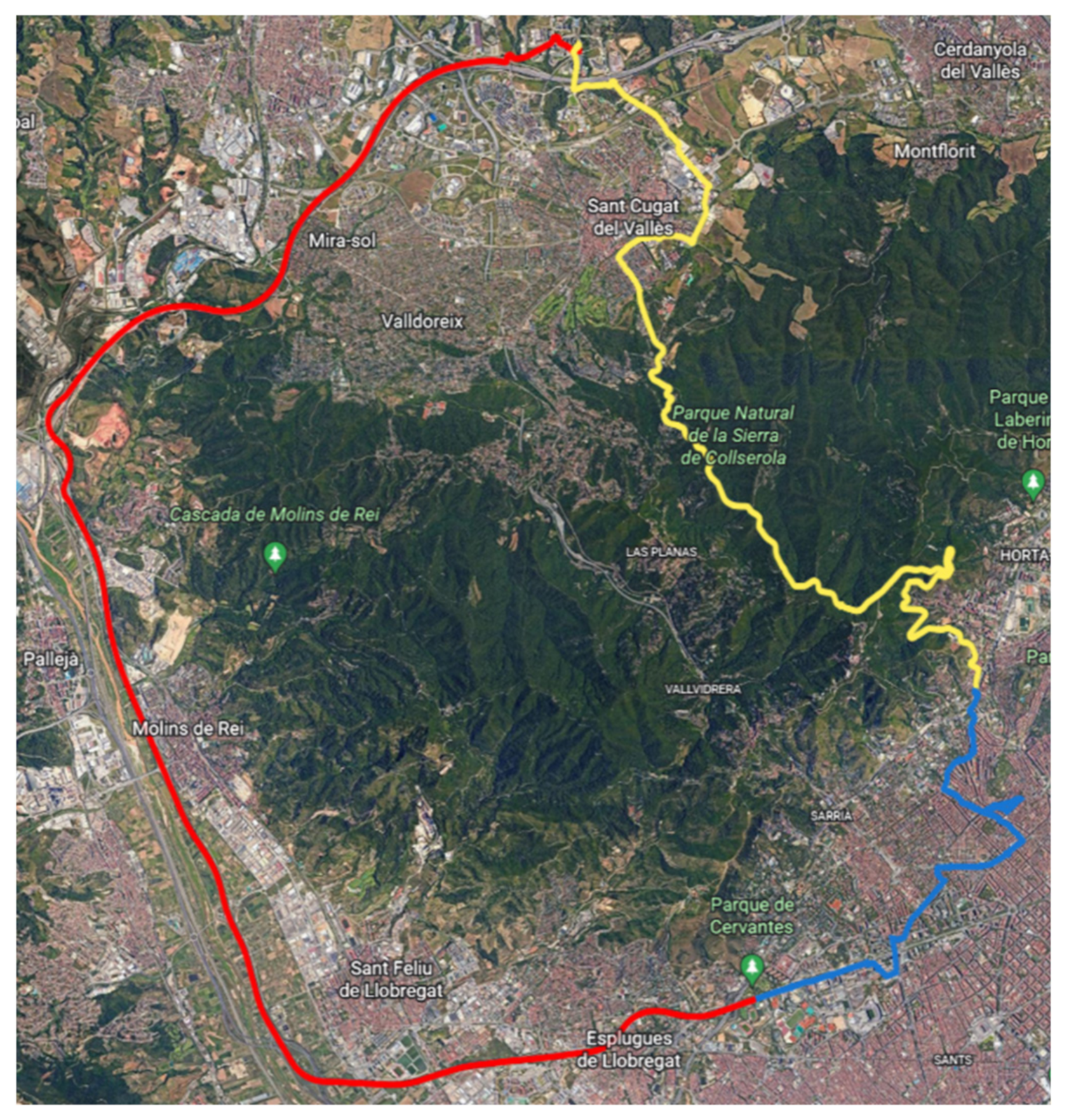
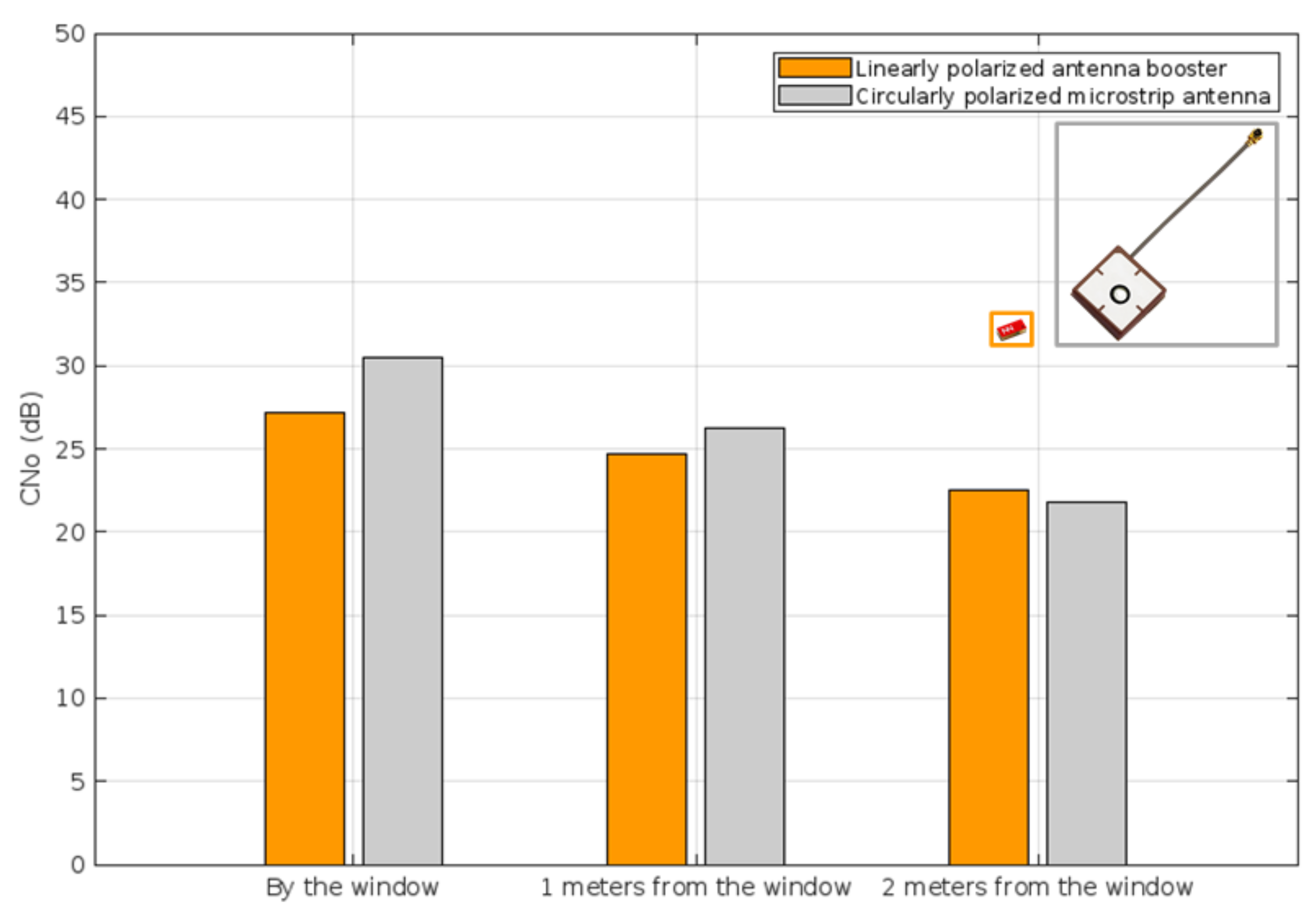
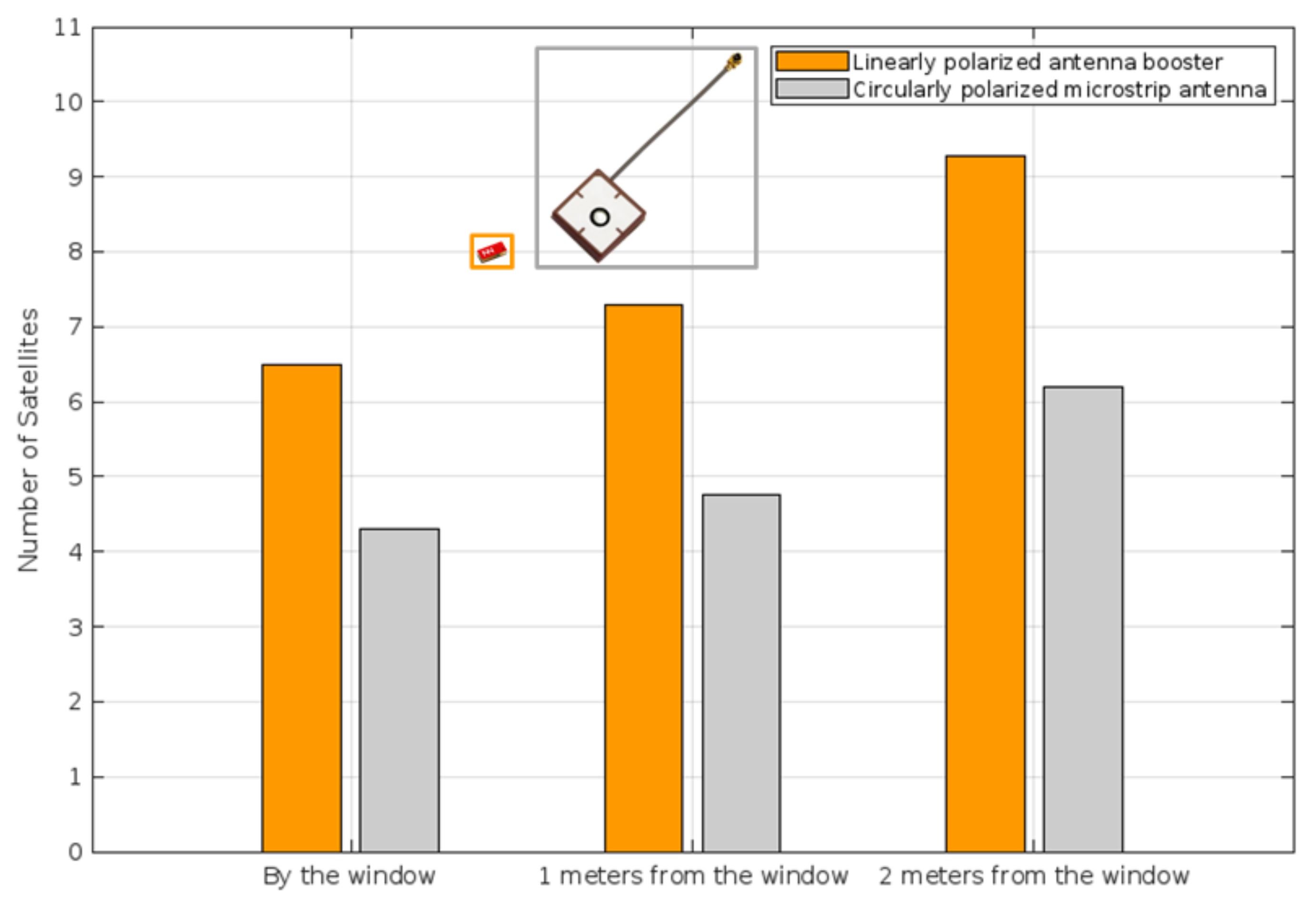


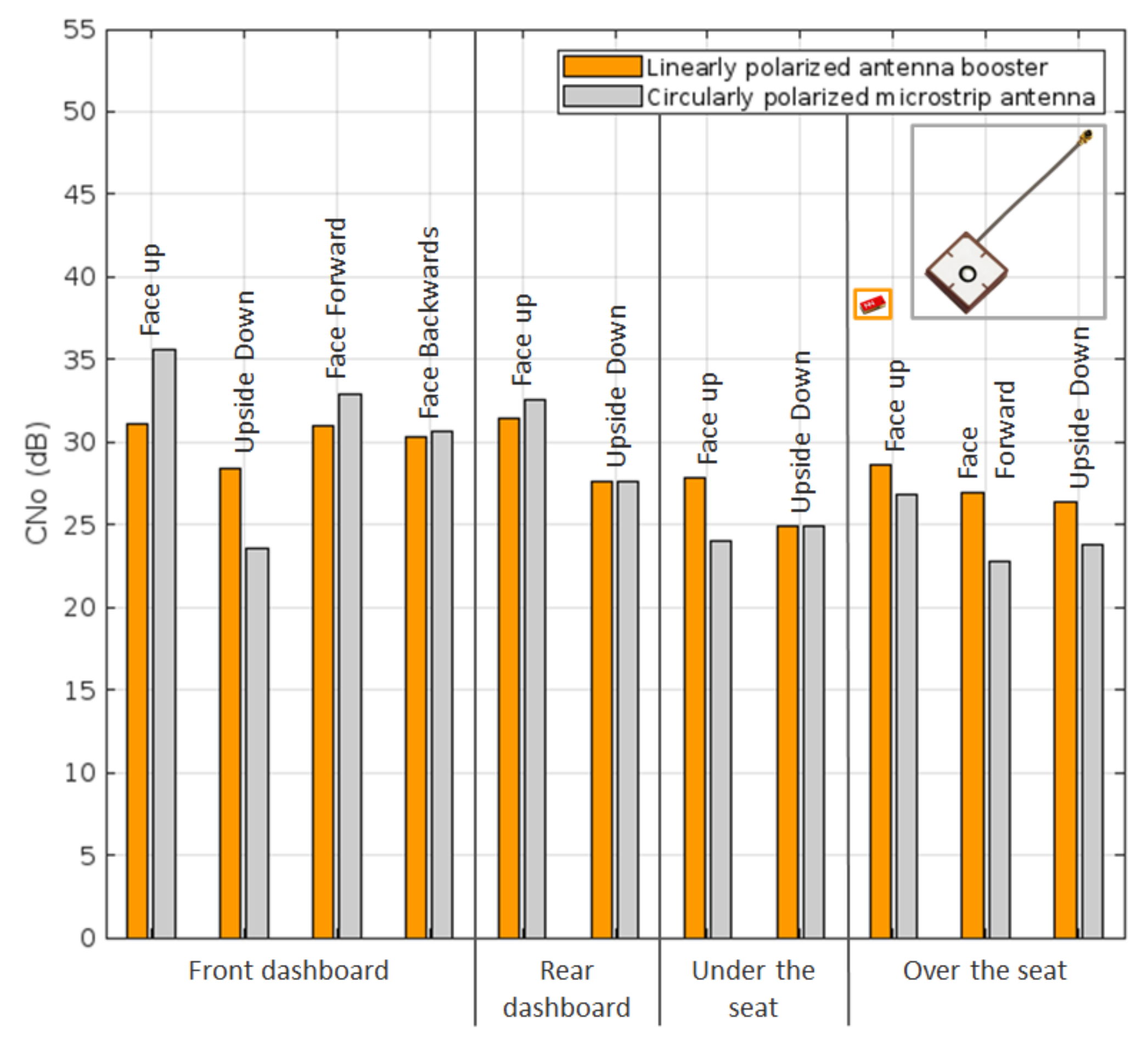
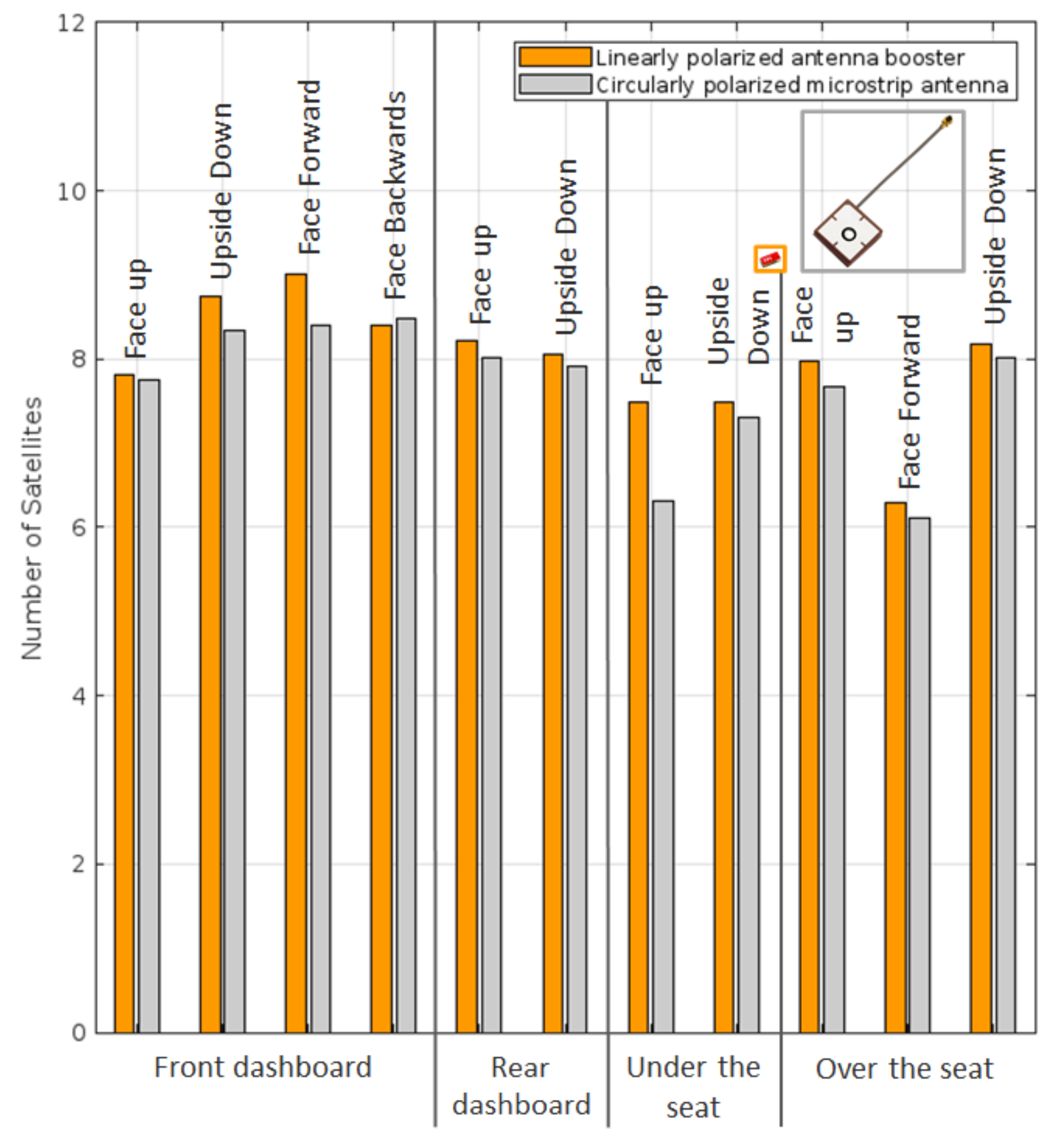

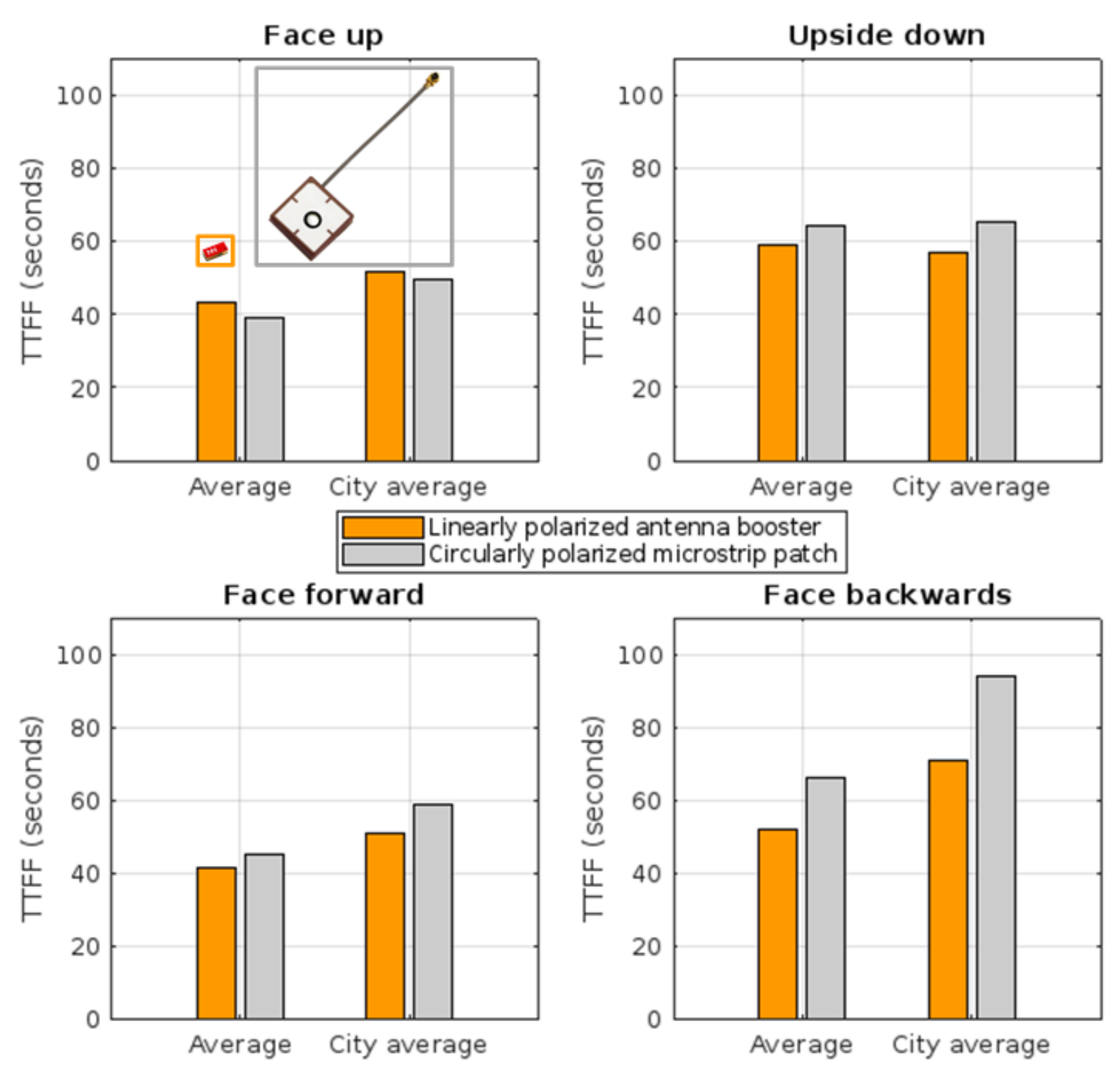

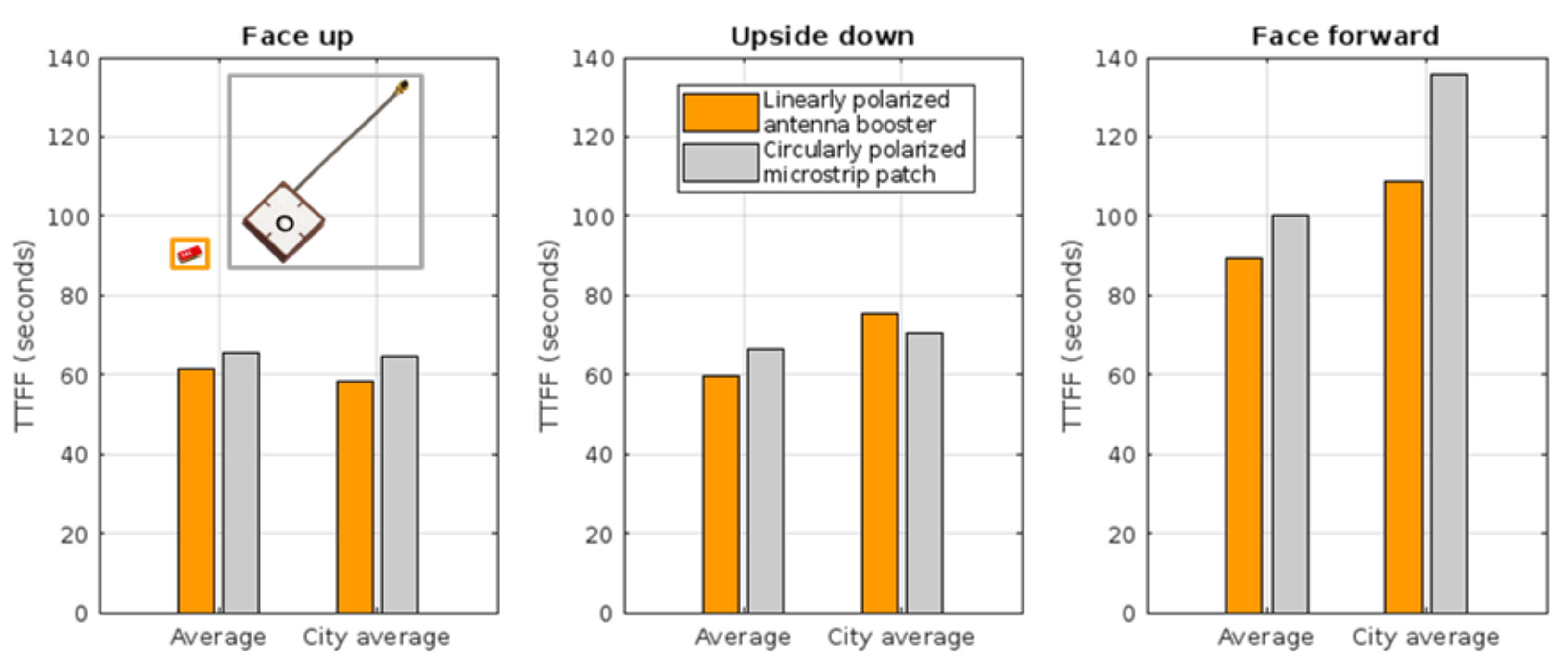


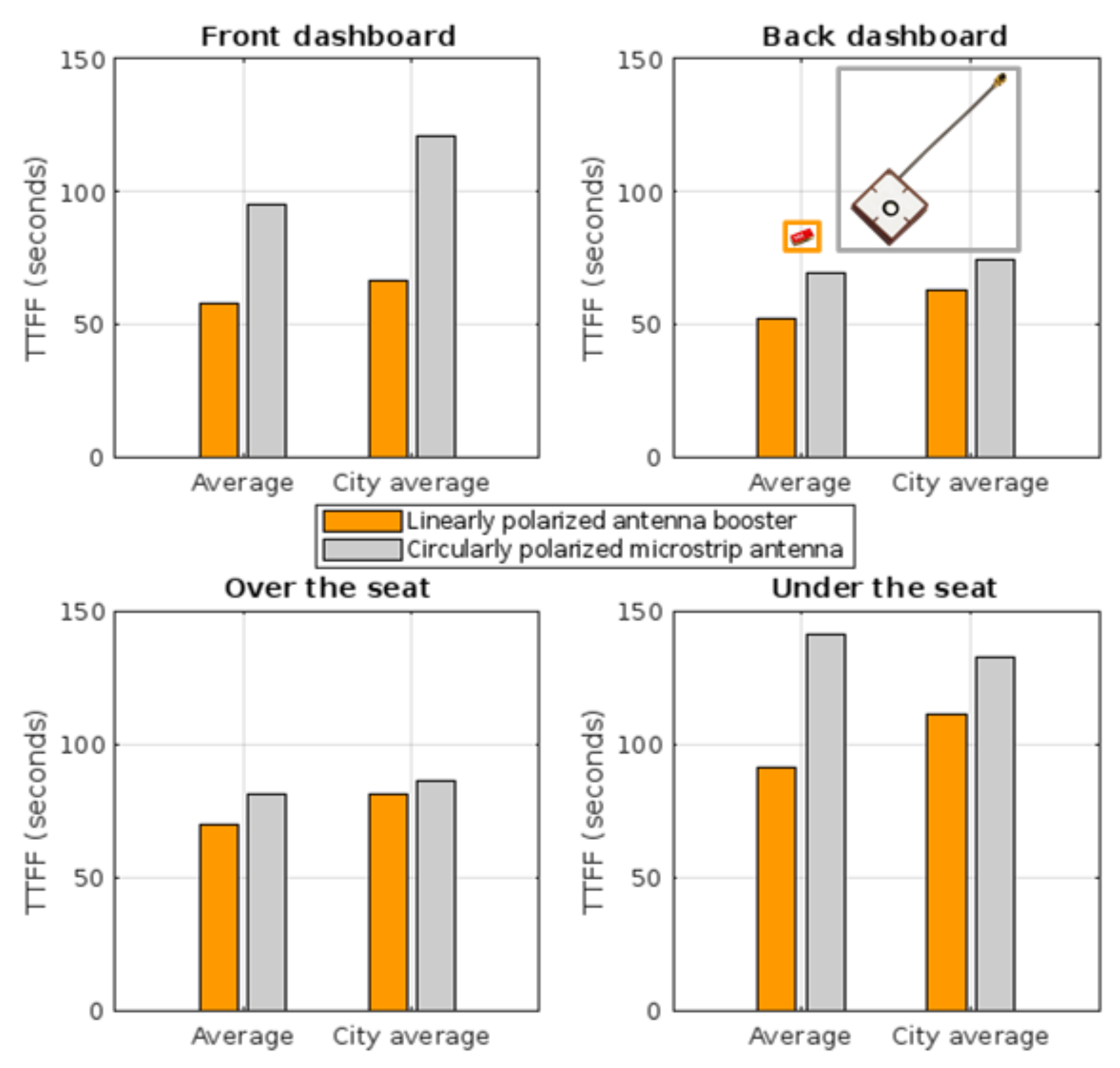
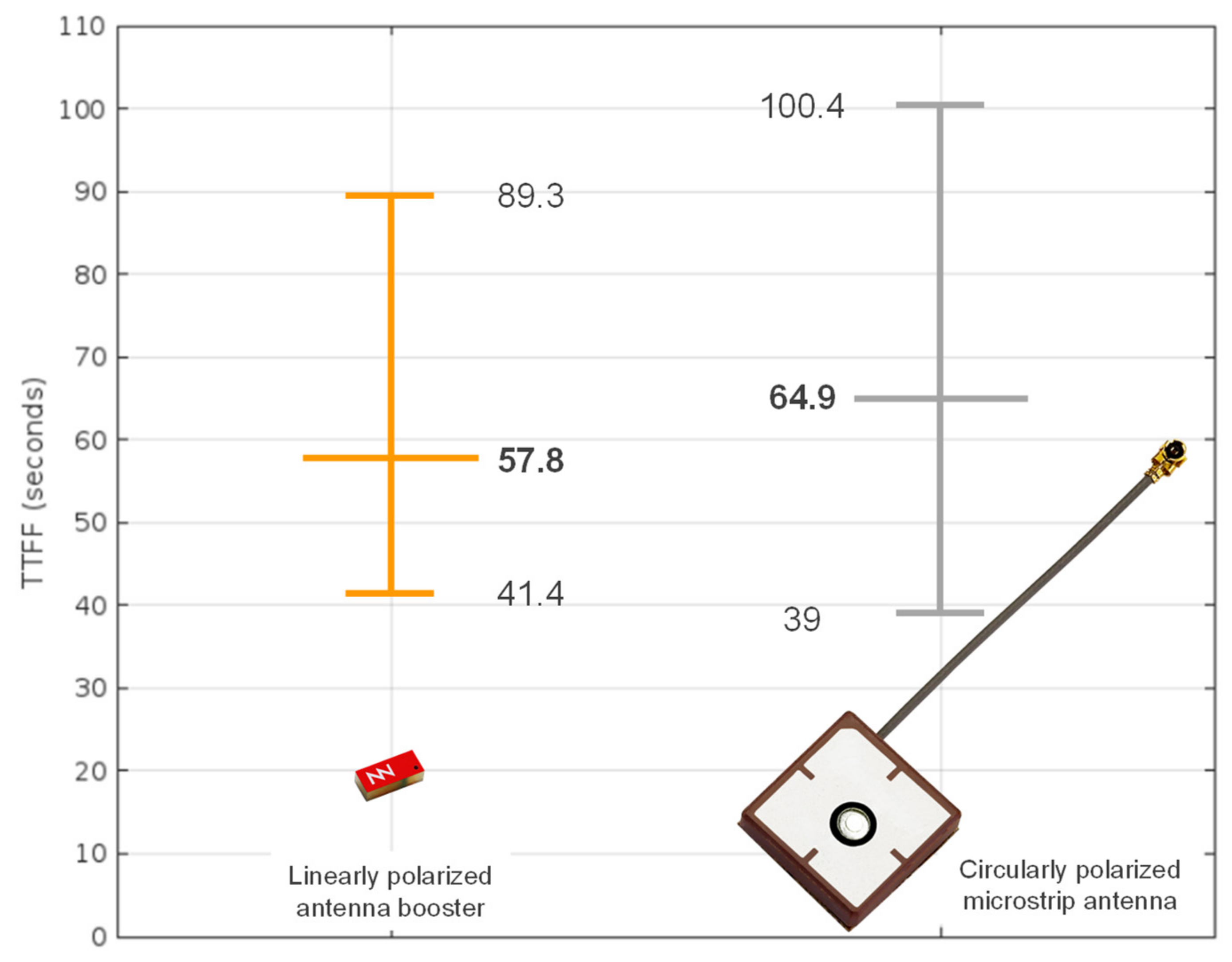
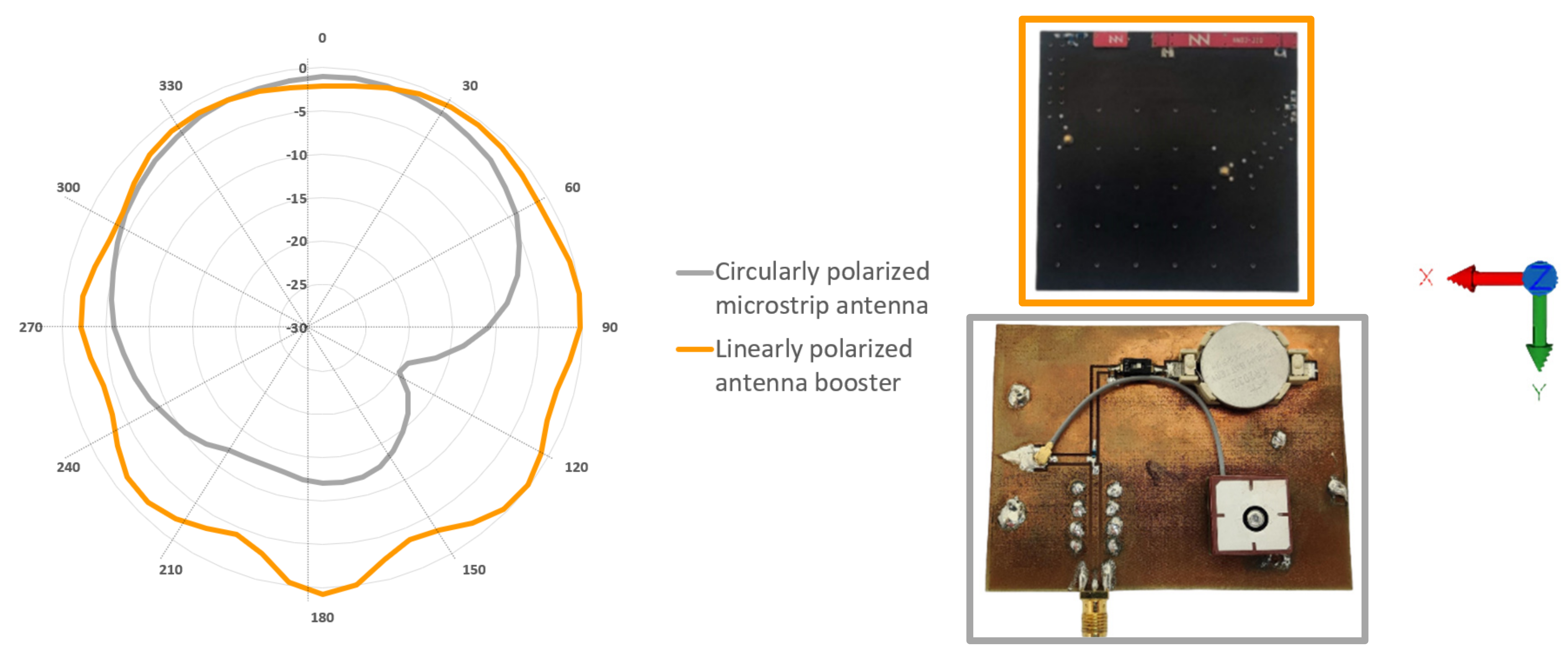

| Parameter | Antenna Booster | Microstrip Antenna |
|---|---|---|
| Frequency | 1575 MHz | 1575.42 ± 1.023 MHz |
| Dimensions | 7.0 × 3.0 × 2.0 mm3 | 17.0 × 17.0 × 4.0 mm3 1 |
| Peak Gain | −2.1 dBi Typ. @ Zenit | −1.0 dBi Typ. @ Zenit |
| Polarization | Linear | RHCP |
| Radiation pattern | Omnidirectional | NE |
| Impedance | 50 Ω | 50 Ω |
| Parameter | Antenna Booster | Microstrip Antenna |
|---|---|---|
| Frequency | 1575.42 MHz | 1575.42 MHz |
| Gain | 16.5 dB 1 | 16 dB 1 |
| Noise figure | 1.03 dB | 2.5 dB |
| Circular Pol.: Microstrip Patch Antenna | Linear Pol.: Antenna Booster | |
|---|---|---|
 |  | |
| Volume of the antenna part | 17.0 × 17.0 × 6.1 mm3 | 7.0 × 3.0 × 2.0 mm3 |
| Automatic pick and place | No | Yes |
| TTFF average in a static ideal position | 29 s | 27.9 s |
| TTFF total average | 64.9 s | 57.8 s |
| Omnidirectional radiation pattern | No | Yes |
| BoM | Ceramic patch, LNA, coaxial line, and receptacles at the microstrip antenna and PCB | Antenna booster, LNA, and a matching network are all placed on the PCB |
Publisher’s Note: MDPI stays neutral with regard to jurisdictional claims in published maps and institutional affiliations. |
© 2022 by the authors. Licensee MDPI, Basel, Switzerland. This article is an open access article distributed under the terms and conditions of the Creative Commons Attribution (CC BY) license (https://creativecommons.org/licenses/by/4.0/).
Share and Cite
Gui, J.; Leiva, J.L.; Andújar, A.; Groot, J.; Pijoan, J.L.; Anguera, J. Linearly Polarized Antenna Boosters versus Circularly Polarized Microstrip Patch Antennas for GPS Reception in IoT Devices. Energies 2022, 15, 9623. https://doi.org/10.3390/en15249623
Gui J, Leiva JL, Andújar A, Groot J, Pijoan JL, Anguera J. Linearly Polarized Antenna Boosters versus Circularly Polarized Microstrip Patch Antennas for GPS Reception in IoT Devices. Energies. 2022; 15(24):9623. https://doi.org/10.3390/en15249623
Chicago/Turabian StyleGui, Jaime, José L. Leiva, Aurora Andújar, Jaap Groot, Joan L. Pijoan, and Jaume Anguera. 2022. "Linearly Polarized Antenna Boosters versus Circularly Polarized Microstrip Patch Antennas for GPS Reception in IoT Devices" Energies 15, no. 24: 9623. https://doi.org/10.3390/en15249623
APA StyleGui, J., Leiva, J. L., Andújar, A., Groot, J., Pijoan, J. L., & Anguera, J. (2022). Linearly Polarized Antenna Boosters versus Circularly Polarized Microstrip Patch Antennas for GPS Reception in IoT Devices. Energies, 15(24), 9623. https://doi.org/10.3390/en15249623








